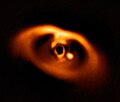The ESI, as proposed in 2011 by Schulze-Makuch et al. in the journal Astrobiology , incorporates a planet's radius, density, escape velocity, and surface temperature into the index. [1] Thus the authors describe the index as having two components: (1) associated with the interior which is associated with the mean radius and bulk density, and (2) associated with the surface which is associated with the escape velocity and surface temperature. An article on the ESI formulation derivation is made available by Kashyap Jagadeesh et al.(2017). [2] ESI was also referenced in an article published in Revista Cubana de Física . [3]
For exoplanets, in almost every case only the planet's orbital period along with either the proportional dimming of the star due to the planet's transit or the radial velocity variation of the star in response to the planet is known with any degree of certainty, and so every other property not directly determined by those measurements is speculative. For example, while surface temperature is influenced by a variety of factors including irradiance, tidal heating, albedo, insolation and greenhouse warming, as these factors are not known for any exoplanet, quoted ESI values use planetary equilibrium temperature as a stand-in. [1]
A webpage maintained by one of the authors of the 2011 Astrobiology article, Abel Méndez at the University of Puerto Rico at Arecibo, lists his calculations of the index for various exoplanetary systems. [4] Méndez's ESI is calculated as
 ,
,
where  and
and  are properties of the extraterrestrial body and of Earth respectively,
are properties of the extraterrestrial body and of Earth respectively,  is the weighted exponent of each property, and
is the weighted exponent of each property, and  is the total number of properties. It is comparable to, and constructed from, the Bray–Curtis Similarity Index. [4] [5] The weight assigned to each property,
is the total number of properties. It is comparable to, and constructed from, the Bray–Curtis Similarity Index. [4] [5] The weight assigned to each property,  , are free parameters that can be chosen to emphasize certain characteristics over others or to obtain desired index thresholds or rankings. The webpage also ranks what it describes as the habitability of planets and moons according to three criteria: the location in the habitable zone, ESI, and a speculation as to a capacity to sustain organisms at the bottom of the food chain, a different index collated on the webpage identified as the "Global Primary Habitability scale". [6]
, are free parameters that can be chosen to emphasize certain characteristics over others or to obtain desired index thresholds or rankings. The webpage also ranks what it describes as the habitability of planets and moons according to three criteria: the location in the habitable zone, ESI, and a speculation as to a capacity to sustain organisms at the bottom of the food chain, a different index collated on the webpage identified as the "Global Primary Habitability scale". [6]
The 2011 Astrobiology article and the ESI values found in it received press attention at the time of the article's publication. As a result, Mars was reported to have the second-highest ESI in the Solar System with a value of 0.70. [7] A number of exoplanets listed in that article were reported to have values in excess of this.
Other ESI values that have been reported by third parties include the following sources: [7] [4]
No relation to habitability
Although the ESI does not characterize habitability, given the point of reference is the Earth, some of its functions match those used by habitability measures. As with the definition of the habitable zone, the ESI uses surface temperature as a primary function (and the terrestrial point of reference). A 2016 article uses ESI as a target selection scheme and obtains results showing that the ESI has little relation to the habitability of an exoplanet, as it takes no account of the activity of the star, planetary tidal locking, nor the planet's magnetic field (i.e. ability to protect itself) which are among the keys to habitable surface conditions. [8]
It has been noted that ESI fails to differentiate between Earth similarity and Venus similarity, where planets with a lower ESI have a greater chance at habitability. [9]
This page is based on this
Wikipedia article Text is available under the
CC BY-SA 4.0 license; additional terms may apply.
Images, videos and audio are available under their respective licenses.








